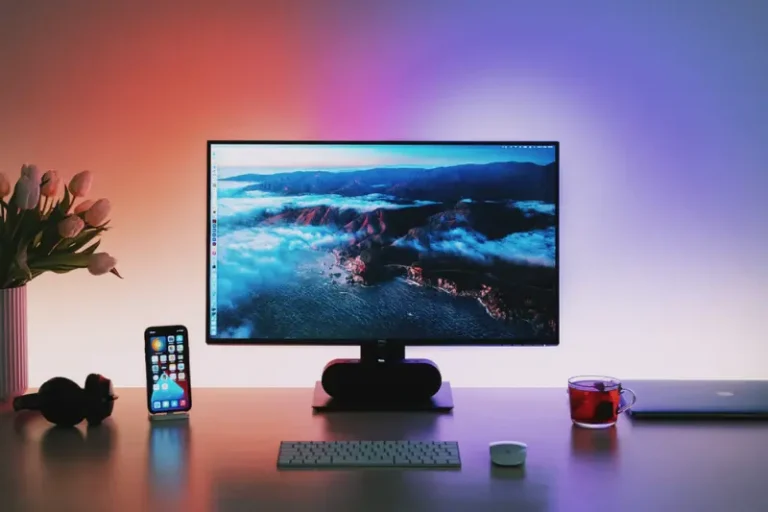The Best Keyboards Buying Guide

How to Choose the Perfect Keyboard for Your Hands!
Keyboards, once merely seen as ‘input devices that just need to work,’ have recently become one of the most popular IT gadgets, often ranking 1st or 2nd in portal search trends. As a product that your hands directly interact with for long periods in daily life, it’s best to use a keyboard that perfectly fits your needs and preferences.
Let’s explore how to choose the keyboard that’s just right for you among the many diverse products available, with Nosearch!
Chapter 1.
Types of keyboard
Membrane / Scissor-switch / Mechanical / Contactless
While most keyboards look similar, they are classified into various types based on how keys are inputted (contact method). Let’s look at the most commonly used keyboards and their respective advantages and disadvantages.
1. Membrane Keyboard
Most affordable and versatile
Recommended if you use it for short periods or don’t want to invest much in key feel
Affordable and the most common keyboard
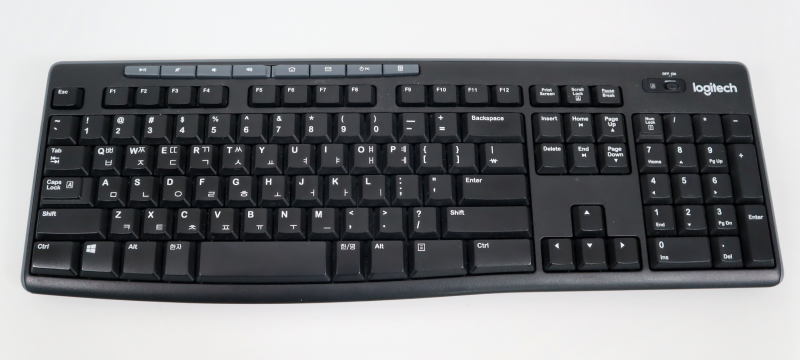
First, let’s look at the membrane keyboard, which is currently the most widely used. Often included as a default with computer purchases, it’s commonly seen in schools and offices. If you bought a product in the $10-30 range without much thought, it’s likely a membrane keyboard.
Few malfunctions and safe from dust/foreign substances Limited simultaneous input and inferior key feel are drawbacks
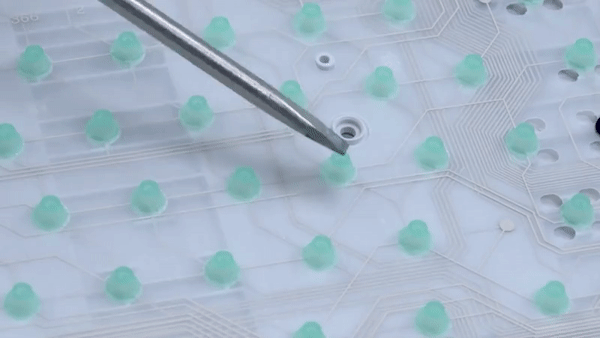
Membrane keyboards work by pressing a switch attached to the keycap onto a convex rubber (rubber dome) below. The advantages of this method are: ① Simple structure leads to fewer malfunctions ② Relatively safe even if dust gets between keycaps or drinks are spilled ③ Typing noise is relatively low
On the other hand, the disadvantages are: ① Limited ‘simultaneous input’ of multiple keys due to its integrated structure ② Inferior key feel compared to other methods
While it’s the most used due to its low price, its performance is accordingly moderate. It’s most recommended for those who don’t use keyboards frequently or don’t prioritize key feel.
2. Scissor-switch Keyboard
The thinnest and slimmest keyboard
Recommended if attractive design and portability are important
Attractive design and portability are advantages
Flat key feel and weak durability are disadvantages

Scissor-switch keyboards are mainly used in laptops. They have a similar operating principle and internal structure to membrane keyboards, but their keycaps are less than half as thick and smaller in size.
The advantages of this method are: ① Thin and slim design. A typical product is Apple’s Magic Keyboard ② Low key pressure makes it the quietest and less stressful on hands even during long use ③ Small size offers excellent portability and space efficiency, often released as wireless models

The disadvantages include: ① Somewhat flat key feel, low key pressure means it lacks the so-called ‘typing satisfaction’ ② Weak durability, thin keycaps often peel off, or internal supports break easily
Therefore, this keyboard is recommended for those who prefer simple and attractive designs over key feel, or for those looking for small, light, and portable keyboards.
3. Mechanical Keyboard
Characterized by distinctly noticeable key feel
Recommended for those who prioritize key feel or for gaming use
Physical contact method with individual switches
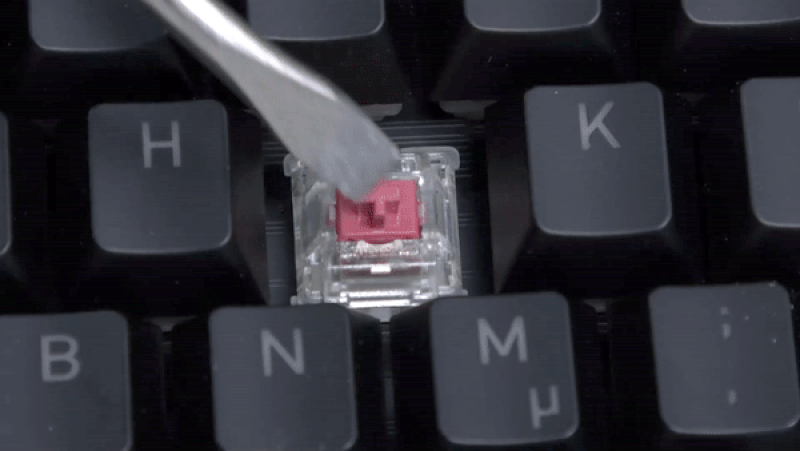
Mechanical keyboards are characterized by individual switches called ‘stems’ for each key. Unlike membrane keyboards, signals are transmitted through direct contact of the switch.
※ Membrane: Signal transmission through rubber dome contact
Distinct key feel, unlimited simultaneous input, and various other advantages
High price and loud noise are disadvantages

Due to these structural differences, mechanical keyboards have distinct features compared to other keyboards. ① The biggest advantage commonly cited by mechanical keyboard enthusiasts is the excellent typing feel. Even for the same product, you can choose switches with desired key feel such as Blue/Red/Brown/Black switches, and replace them if needed. ② Fast typing is facilitated by using the repulsive force of internal springs ③ Unlimited simultaneous input is possible as there’s no key conflict between individual switches ④ Many products come with colorful and diverse backlights, and individual key replacement allows for easy customization. This is particularly popular among gamers as it allows them to show their personality.
On the other hand, the disadvantages are: ① Relatively high price range, starting from $30-50 and many products over $100 ② Loud noise that can be distracting in quiet places (There are some low-noise products like non-click switches, but they’re still louder than membrane or scissor-switch keyboards.)
Many users say, “Once you get used to it, membrane keyboards feel too restrictive to use,” and more people are using mechanical keyboards for their unique and attractive key feel. Following this trend, many affordable entry-level products are now being released. We recommend these for those who work long hours on keyboards, enjoy a distinct key feel, or play games requiring fast response times and simultaneous inputs.
Clicky switch: The PC bang in your hands
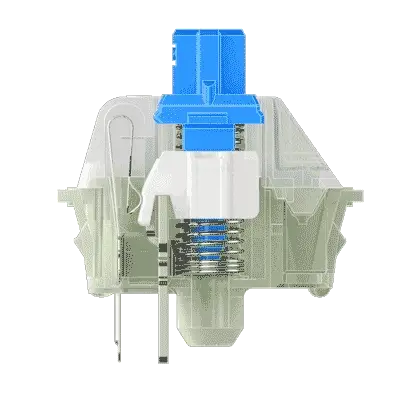
Typing sound occurs due to the slider
Clicky switches are popular for their refreshing typing feel with noticeable distinction and their crisp clicking sound. It’s easy to understand if you think of PC bang keyboards. However, because they’re very loud, they’re not suitable for use in quiet places like offices or schools.
Linear switch: Smooth typing feel with quiet noise
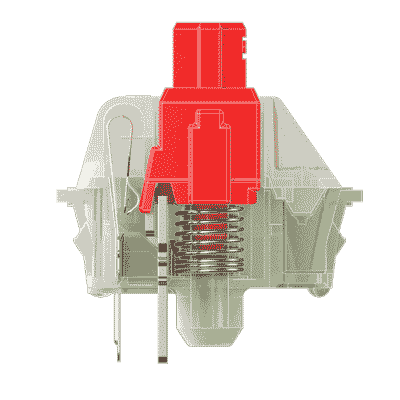
Less noise due to absence of slider
Unlike clicky switches, red switches don’t have a noticeable distinction feel at the fingertips, and keys go down smoothly without resistance when pressed. Because they’re relatively quiet and lack distinction, some gamers say they lack satisfying feedback. Therefore, these switches are suitable for situations where you need to work for long hours in quiet places like offices.
Tactile switch: Combining the advantages of blue and red switches
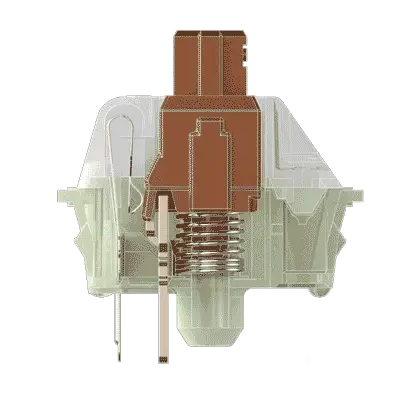
Less noise due to absence of slider
Tactile switches retain the refreshing typing feel of Clicky switches while reducing the noise. The sound is somewhat louder than red switches and characteristically makes a rustling noise. They maintain an interesting typing feel while being relatively quiet, making them the most recommended switch for beginners.
4. Contactless Keyboard
Combines advantages of membrane and mechanical keyboards
Recommended for high workload or those seeking a unique keyboard
Transmits signals without physical contact
The most advanced method, also the most expensive

Contactless keyboards are often called the “ultimate keyboards.” Many users upgrade from membrane to mechanical and then to contactless keyboards due to their excellent key feel, quiet operation, and various other advantages. They are technically the most advanced as they are the only keyboards that operate without physical contact (point of contact), which is reflected in their high price.
In the past, “contactless” referred only to capacitive methods, but with the development of optical switch technology, both capacitive and optical switches are now classified as contactless keyboards.
Capacitive: Detecting input through voltage
Capacitive keyboards transmit signals through changes in voltage when a key is pressed. Generally, “contactless keyboard” refers to capacitive keyboards. The internal structure composed of keycaps, rubber domes, and springs is similar to membrane keyboards, but they differ in having no contact points and individual switches. They typically use high-quality rubber domes with better durability compared to membrane keyboards.
Advantages: ① Less fatigue even during long use due to less force required for typing ② Quiet operation and excellent durability due to no physical impact ③ Unique soft and chewy key feel, unlimited simultaneous input due to individual switches, and fast response time, combining the advantages of membrane and mechanical keyboards
Disadvantages: ① High price, starting from at least $100 ② Key feel may change over long-term use due to hardening of rubber domes
This type is recommended for those who do a lot of keyboard work, like programmers, as it provides both satisfactory key feel and quiet operation. It’s also a good choice for those seeking a unique keyboard that sets them apart from others.
Optical: Detecting input with infrared sensors
Optical switches use sensors that recognize signals using light, such as infrared. While they are contactless like capacitive switches, they have features similar to mechanical keyboards due to the use of mechanical switches.
Advantages of optical switches: ① Less strain on hands compared to mechanical switches due to the contactless method ② Excellent durability with no corrosion/wear issues and easy waterproofing implementation
Disadvantage: ① Difficult to repair once broken due to the use of light for input detection
This type is suitable for office use as it offers the key feel of mechanical keyboards with relatively less hand fatigue. It’s also recommended for those looking for a “durable mechanical keyboard” for gaming purposes.
Chapter 2.
Key Feels
Key feel refers to the sensation or feeling when pressing a keyboard key. It’s not about good vs. bad, but entirely a matter of personal preference. However, the difference in key feel between products is often the main reason people change keyboards.
Different key feels can affect pressure, distinction, and rebound force. This can lead to differences in wrist fatigue or typing error frequency depending on the user. While key feel varies with keyboard type and switch, it’s mainly influenced by key pressure, key travel, and keycap quality.
1. Key Pressure
Higher pressure gives a more distinct feel
Lower pressure causes less wrist fatigue
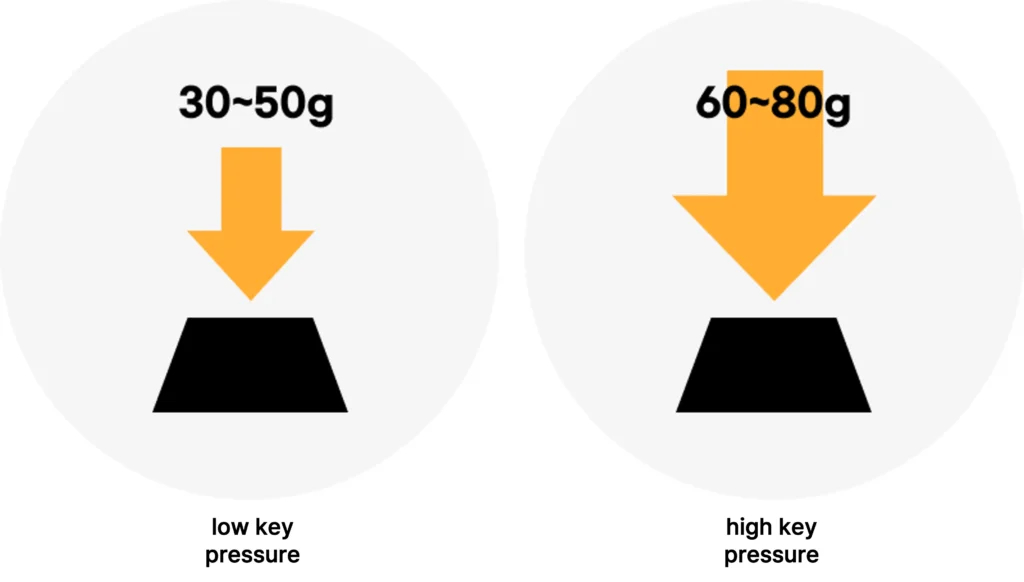
Key pressure refers to how much weight (pressure) is needed to register a keypress, measured in grams. Low-pressure products range from 30 to 50g, while high-pressure ones are about 60 to 80g. Key pressure is determined by keyboard type, rebound force, key size, and weight. Higher pressure requires more force to input, while lower pressure allows input with less force.
You might think lower pressure is better, but it can lead to weaker distinction between keypresses and more typos due to accidental presses. On the other hand, while higher pressure might cause wrist fatigue during long use, it provides a more distinct, “chewy” feel and allows for more accurate typing.
Note that people with strong finger grip might not notice the difference, while those with less strength might feel it more, leading to varying preferences.

Among keyboard types, scissor-switch has the lowest pressure at 30-40g. For mechanical keyboards, red and brown switches are low at 40-55g, while black switches are high at over 60g. Membrane keyboards generally range from 40-60g, but vary widely between products.
2. Key Travel
Deeper key travel allows for more accurate input
Lower key travel enables faster typing

While key pressure refers to weight, key travel refers to how deeply a key must be pressed to register input, measured in millimeters. Low key travel products are around 1mm, while deep ones can exceed 3mm.
A short key travel allows for faster input and is advantageous for tasks requiring quick response, like rhythm games, but it can also increase typos. Conversely, a deep key travel allows for more accurate typing but slower input.
While similar to key pressure, key travel is more related to speed, while key pressure affects weight and distinction more. Like key pressure, it’s a matter of preference, so choose based on your keyboard’s intended use and your typing habits.

Among keyboard types, membrane keyboards are deep at 3-4mm. Mechanical keyboards vary by switch, but some “speed” switches like silver and certain scissor-switch products have short 1-2mm key travel.
3. Keycaps
Keycaps can affect key feel
Keycap quality varies widely
While input-related factors like key pressure and key travel affect key feel, the material, height, and weight of keycaps, where fingers directly contact the keyboard, also create differences in feel.
Material affects texture
Even among plastics, durability and quality vary by material. ABS, used in budget products, is cheap but wears quickly, changing its initial feel over time. PBT, while more expensive to manufacture, has a naturally soft surface feel and is wear-resistant, maintaining a consistent key feel.
Taller keycaps feel heavier
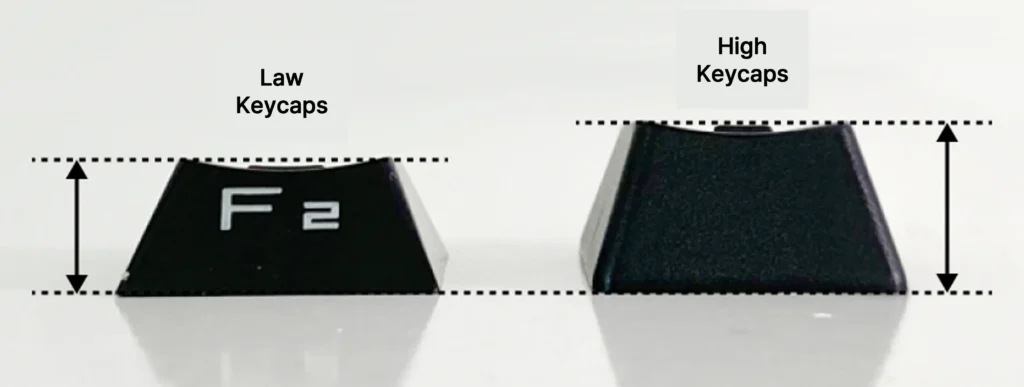
Common keycap profiles include Cherry and OEM. Cherry has lower keycaps, while OEM has taller ones. Lower keycaps make typing sound heavier and slightly reduce key pressure, often used with red/black switches. Taller keycaps feel heavier and make typing sound lighter, used with blue switches.
Keycap weight/thickness also affects feel but is hard to check
Keycap thickness and weight can impact key feel as much as height.
Generally, about 1mm is thin, 1.3mm is medium, and 1.5mm is thick. Like height, thicker keycaps make typing sound heavier and cleaner, while lighter ones make it lighter. Thinner keycaps suit blue switches, while thicker ones suit red and black switches. However, while keycap height information is relatively easy to find in product details or reviews, weight and thickness are harder to determine before purchase. Therefore, it’s okay to focus mainly on keycap height when considering these factors.
Chapter 3.
Connection Method of keyboard
Wired vs. Wireless
1. Wired Keyboard
Recommended if price and stability are more important than portability
Basic connection method with a wide range of product options
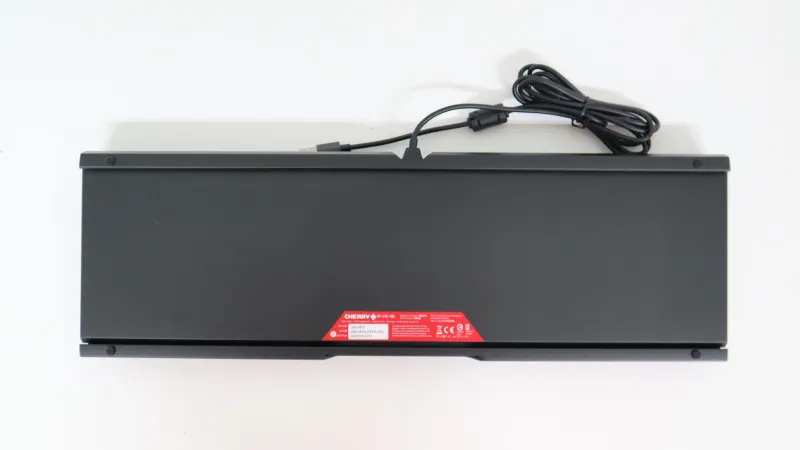
Wired connection is the most basic method for keyboards. Most manufacturers primarily release wired versions, offering a wider range of products compared to wireless options. Since power is supplied through the cable, wired keyboards often feature backlighting, which is less common in battery-operated wireless models.
Prices are also about 20-40% lower for comparable specs, as no separate transmitter/receiver is needed.
Connection speed and stability are also advantages
More high-end models tend to be wired
Connection speed and stability are additional benefits of wired keyboards. Unlike wireless keyboards that require signal transmission through a receiver, wired keyboards connect directly to the PC, avoiding potential signal weakening due to distance or obstacles. The response time, which indicates input speed, is also faster for wired keyboards.
This is why over 80% of mechanical keyboards, often used for gaming, are wired. As you move towards higher-end models, where subtle differences in key feel and build quality determine performance, most high-quality keyboards favored by enthusiasts are wired.
Recommended for fixed locations or when connectivity is crucial
We recommend wired products if you’re looking for an affordable keyboard for use in a fixed location, or for activities like gaming or trading where fast and stable connections are essential.
2. Wireless Keyboard
Recommended if convenience and portability are priorities
Wireless keyboards are gaining popularity

Just as wireless earphones have become the norm, wireless keyboards are rapidly growing in popularity due to their overwhelming convenience.
No location constraints and excellent portability
Unlike wired keyboards that can tangle or have limiting cord lengths, wireless keyboards can be placed anywhere on your desk, offering freedom from location constraints and easy portability. Many products also allow you to connect both a mouse and keyboard with a single receiver, which is especially useful for laptops with limited ports. They can also be versatile, working with TVs, laptops, tablets, and gaming systems.
Recommended if convenience and portability are important
Wireless keyboards are definitely recommended for those who need to carry their keyboard often or want to use it without location constraints.
However, for typical home use where the keyboard is connected to a PC in a fixed location, choosing a wired keyboard might be more rational due to the higher price and the hassle of battery replacement associated with wireless models.
Chapter 4.
Appearance of keyboard
1. Key Layout
Choose full-size for frequent number input or short usage periods
Opt for tenkeyless or a combination for better posture and space efficiency
Categorized as full-size or tenkeyless based on the numeric keypad

Key layout refers to the number and arrangement of keys on a keyboard. They are primarily categorized as full-size or tenkeyless based on the presence of a numeric keypad. Additionally, there are mini keyboards that further remove function keys and other elements for an even more compact design.
104-106 keys for full-size, 87-89 keys for tenkeyless without the numeric pad
Full-size keyboards typically have 104 keys in the US standard layout or 106 keys in the Korean layout (which includes additional Korean/Hanja keys). Tenkeyless keyboards remove the numeric keypad, resulting in 87-89 keys. Mini keyboards further eliminate the top row of function keys and modifier keys, leaving 66-68 keys, making them small and light, ideal for external use.
Some products also offer various layouts with additional multimedia keys, power buttons, macro keys, or fewer keys.
Numeric keypad is convenient for number input but can affect posture and space utilization
While the numeric keypad is convenient for tasks involving frequent number input (like using Excel), it has drawbacks in terms of posture maintenance and space utilization.
Since keyboards are primarily used for typing text rather than numbers, placing a full-size keyboard centrally shifts the letter keys to the left. This causes the hands to be positioned leftward when typing and increases arm movement when using the mouse due to the keyboard’s length, making it difficult to maintain proper posture.
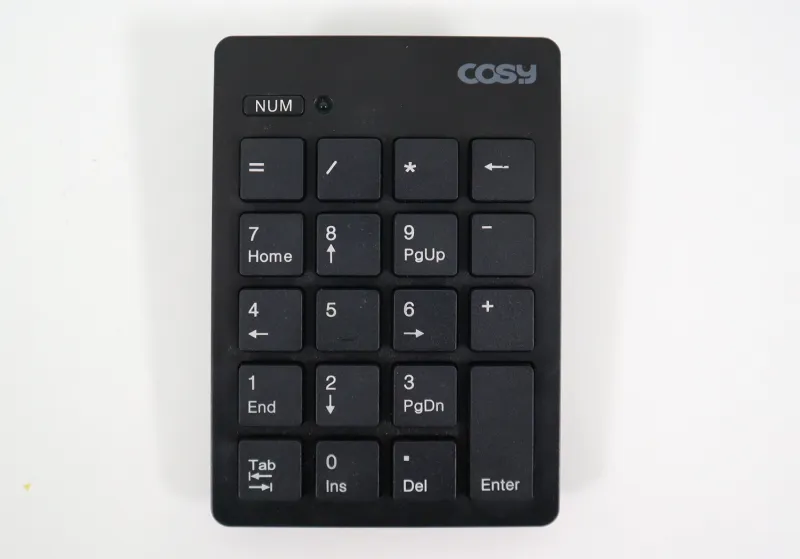
As a result, many users opt for tenkeyless keyboards and purchase separate numeric keypads. However, using a separate numeric keypad requires an additional USB slot and extra cost, which can be inconvenient.
In conclusion, if you frequently use numbers or prefer an all-in-one setup for short usage periods, a full-size keyboard is recommended. If you prioritize proper posture and efficient space usage, consider a tenkeyless keyboard or a combination of tenkeyless and a separate numeric keypad.
2. Keycap Printing Method
Laser etching is the cheapest but has low durability
Most mass-produced keyboards have characters printed on the keycaps. The printing method affects price, durability, and tactile feel. Laser etching, which burns characters onto keycaps with a laser, is the cheapest and simplest method, commonly used in budget keyboards. However, it’s prone to wear over time. To mitigate this, some manufacturers etch on the side of keycaps instead of the top.

Double-shot injection offers excellent durability and readability, now most popular

Double-shot injection combines two plastics to form characters without surface processing. This method ensures near-permanent durability as characters won’t wear off unless the keycap is broken or scratched. It also provides high readability and color vibrancy, making it the most common method from budget to premium keyboards.
Dye-sublimation, mainly used in premium keyboards,offers high durability and consistent feel

Dye-sublimation infuses ink into the keycap material using high heat and pressure. Like double-shot injection, it offers excellent durability, readability, and color reproduction. Unlike laser etching or double-shot injection where the printed area may feel slightly different, dye-sublimation maintains a uniform texture across the keycap. Due to the high-heat process, it’s only possible with relatively expensive PBT material, making it a premium printing method mainly used in high-end keyboards.
3. Design (Step Sculpture)
Most products use Step Sculpture 2; check when buying wireless/mini keyboards
Step Sculpture: Ergonomic design for comfortable typing
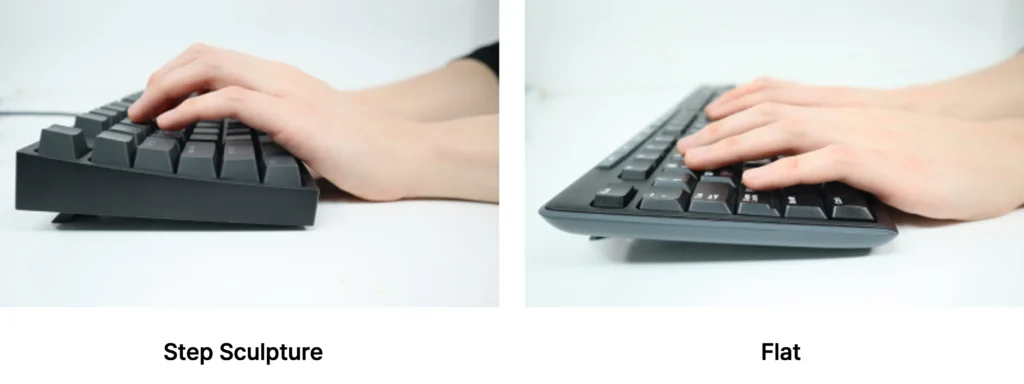
In the past, most keyboards had flat tops, often tilted using rear stands for a comfortable wrist angle. However, the keycaps themselves remained flat, requiring more finger movement or uncomfortable stretching. Step Sculpture design addresses this by adding appropriate curvature to the keyboard, facilitating more natural typing.
Most products now use Step Sculpture 2; check when buying wireless/mini keyboards
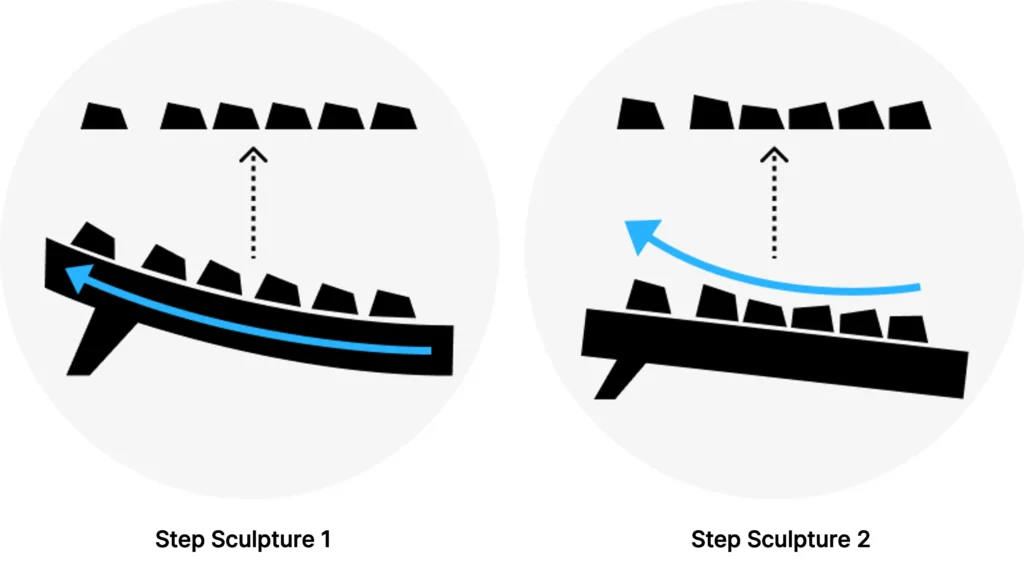
Step Sculpture is divided into Step Sculpture 1, which curves the entire keyboard frame, and Step Sculpture 2, which curves individual keycaps instead of the frame. Most manufacturers now use Step Sculpture 2 as it’s easier to produce.
Step Sculpture 2 is characterized by different shapes for each row of keycaps. Out of the keyboard’s 6 rows, the top 1-3 rows have higher tops, while the bottom 3-6 rows have lower bottoms, allowing comfortable typing regardless of key position.
While Step Sculpture 2 is standard in most recent products and doesn’t require special attention when buying regular keyboards, it’s worth checking for wireless or mini keyboards as some may not incorporate this design.
Chapter 5.
Other Checkpoints
What are the easily missed points when purchasing?
1. Indicators
Surprisingly inconvenient if absent
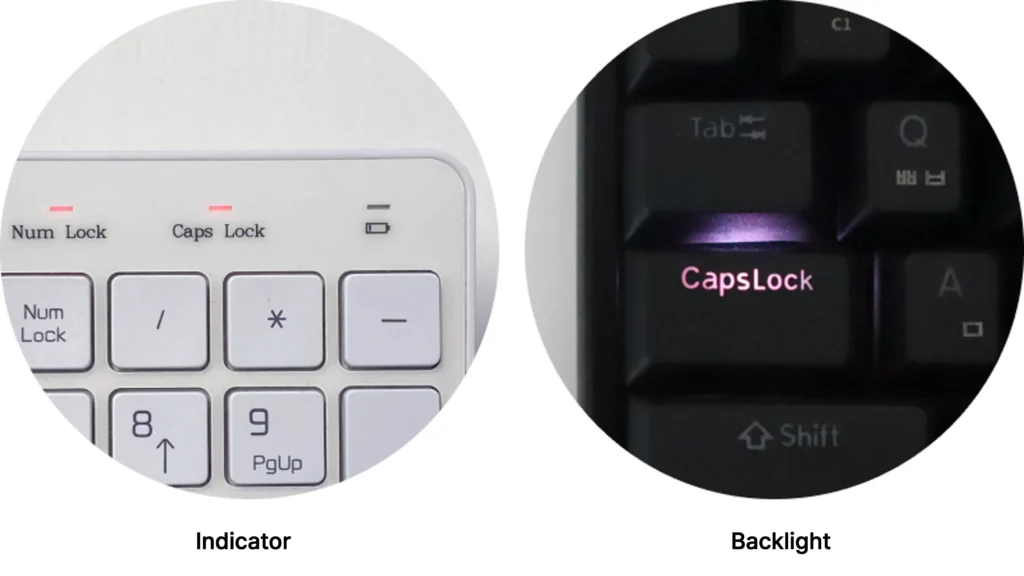
You’ve probably experienced failing to log in due to incorrect capitalization of a password. This inconvenience occurs when the keyboard lacks or has hard-to-recognize lamps indicating uppercase/lowercase.
These lamps, usually located in the upper right corner and showing the status of Num Lock/Caps Lock/Scroll Lock, are called indicators. Some products omit indicators or incorporate them into the keys themselves for space efficiency.
While some individuals may find them unnecessary, they’re generally helpful in preventing common mistakes. We recommend checking for the presence and brightness of indicators before purchasing a keyboard.
2. Cable Length
Recommend a generous cable of at least 150cm
When buying a wired keyboard, cable length is a minor but important checkpoint. Especially if you need to use ports at the back of your computer on a large desk, a short cable can make connections difficult or inconvenient.
Wired keyboard cable lengths typically range from 100cm to 200cm. While individual needs may vary, we recommend choosing a cable of at least 150cm for comfortable connectivity.
3. Keycap Printing Location
Check for top/side printing
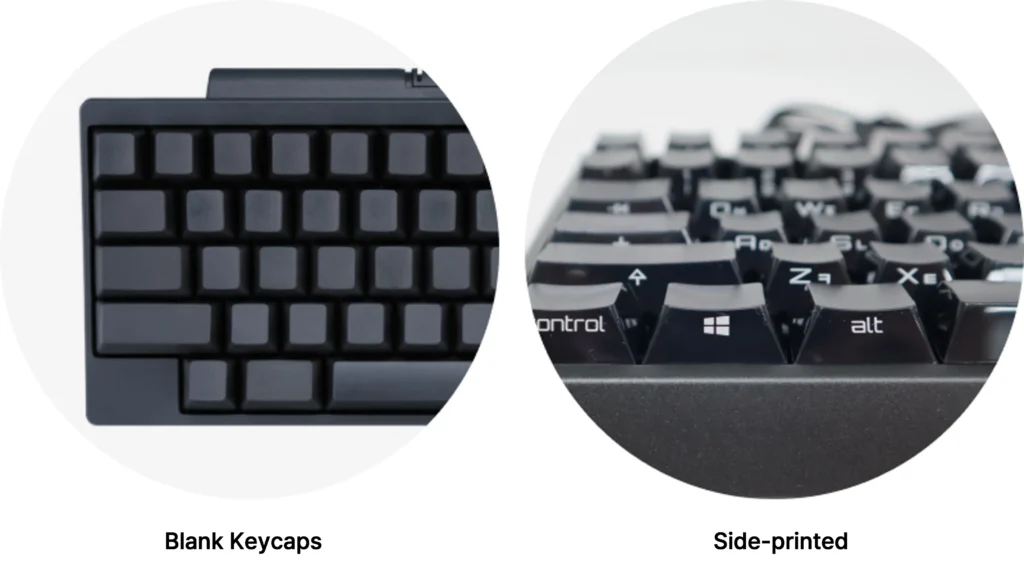
Be cautious when selecting a keyboard based solely on price or other features without considering keycap printing. Some keyboards may have no characters printed (blank keycaps).
Additionally, some products have characters printed on the side of the keycaps (side-printed) rather than the typical top surface (top-printed). If you’re purchasing a foreign-made product, be sure to check the type and location of the printed characters.
4. Weight/Sliding
Light body or poor padding can be inconvenient
Lastly, some users experience inconvenience with keyboards that easily slide due to light weight or poor-quality rubber pads on the bottom. If you’re purchasing a lightweight product (under 1.5 pounds), we recommend checking reviews to ensure there are no sliding issues.



